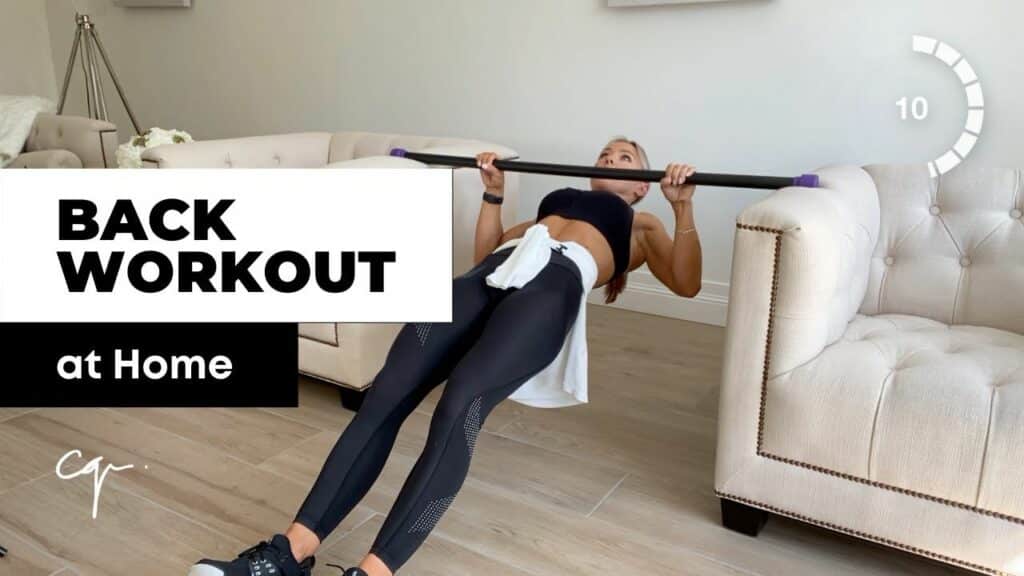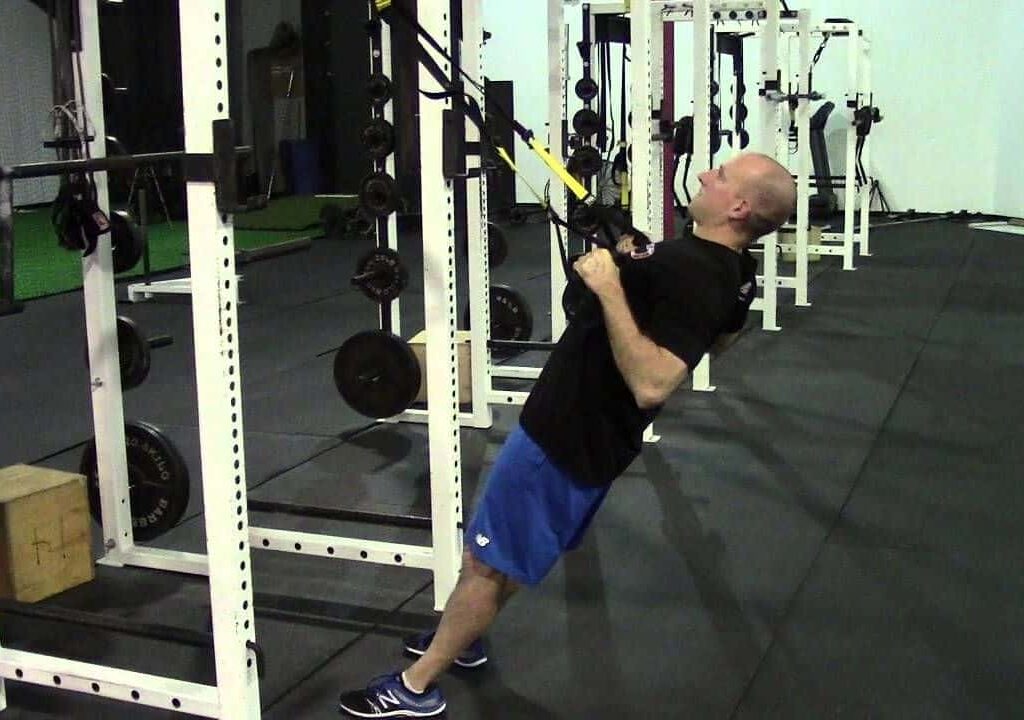Are you tired of doing the same old upper body exercises at the gym? Bringing new exercises into your workouts can keep things interesting and help you maximize muscle growth. One of the best bodyweight exercises to add to your workout rotation is the inverted bodyweight row.
This exercise is one of the simplest and most effective ways of working out your “pull” muscles and improving your upper body strength. Keep reading to find out everything you need to know about inverted rows!
Jump to:
- What is an Inverted Bodyweight Row?
- Which muscles are worked by inverted rows?
- How To Do An Inverted Bodyweight Row
- How to Progress with Inverted Bodyweight Rows (5 Variations)
- When Should I Do Inverted Bodyweight Rows?
- How to Do Inverted Bodyweight Rows at Home
- Benefits of Inverted Bodyweight Rows
- How to Avoid Injuries While Doing Inverted Bodyweight Rows
- Advice for Beginners
- Wrapping Up
What is an Inverted Bodyweight Row?
While you may be familiar with traditional barbell rows, inverted bodyweight rows are slightly different. To do an inverted row, all you need is a bar (often from a squat rack) and your own body weight. This exercise involves you leaning back and pulling to bring your body to the bar. Think of the inverted row to “pulling” as what the bench press is to “pushing.”
Which muscles are worked by inverted rows?
Inverted rows work a number of your muscles. Most importantly, this exercise will strengthen your back muscles: latissimus dorsi, trapezius, rhomboids, infraspinatus, erector spinae, teres minor, and posterior deltoids.

Inverted rows will also work your biceps and forearms. Finally, inverted rows will strengthen a number of secondary muscles and stabilizer muscles found in between the larger ones. Remember — muscle mass is built due to time under tension. This means that you should do your rows slowly to increase the time that your muscles spend under tension.
How To Do An Inverted Bodyweight Row
Inverted, or bodyweight, rows are quite simple. Just follow these six steps:
- The bar’s starting position should be around the waist height. The rack position is important because if you lower the bar, it will become harder to complete the exercise.
- Place yourself lying face up beneath the bar. Failure to maintain perfect form from the start is one of many common mistakes that can cause injuries.
- Using an overhand grip, grab the bar and space out your hands around shoulder-width apart.
- Hold your entire body in a straight line as you squeeze your core muscles and butt. Keep your body tense the whole time!
- Pull your body up to meet the bar. Your chest should touch the bar before you lower.
- Lower back to the ground while maintaining body awareness and core stability.
How to Progress with Inverted Bodyweight Rows (5 Variations)
Not everyone can do inverted rows right away, and that’s perfectly fine! Here are 5 alternatives that serve as a foundation to increase muscle strength and progress to the original exercise.
#1) Doorway Rows
Doorway rows are an awesome way to begin training your pull muscles. Unlike the more vertical pull of traditional bodyweight rows, doorway rows can be performed by holding onto a door frame with outstretched arms and then pulling your body towards the frame. This exercise is also great because you don’t need a pull-up bar.
#2) Towel Rows
Towel rows are like doorway rows, but they offer an added level of difficulty. Simply wedge a towel in between a door and its door frame. Now you can hold on to the towel, lean back, and perform a basic bodyweight pull as you would with any other row.
#3) Inverted Row (High or Low)
You can play around with the height of your bar to increase or decrease the difficulty of inverted rows. The higher the bar, the easier the row. Alternatively, when you lower the bar, your row will be harder. These row variations are important to keep in mind as you grow stronger.

#4) Elevated Inverted Row
If you’re an advanced lifter and normal inverted rows are too easy for you, try elevating your feet on a stool to bring your body angle to a completely horizontal position. Unlike normal inverted rows that place your body at a 45-degree angle, elevated inverted rows are sure to test your strength level.
#5) Inverted Row (Weighted)
Finally, if you have tried all six of these rows and still need more difficulty, you can wear a weighted vest or place a plate on your stomach for more of a challenge. Sometimes bodyweight movements are simply too easy for the most experienced lifters.
When Should I Do Inverted Bodyweight Rows?
You can add bodyweight rows to your workout plans whenever you would normally do pull exercises like classic pull-ups, weighted rows, or pull-downs. Bodyweight exercises are a great way to tone your muscles and increase your range of motion.
How to Do Inverted Bodyweight Rows at Home
There are a few different options for people who want to do inverted rows from the comfort of their homes.
- Option 1: Use a kitchen table or desk to do your inverted rows. Start by lying on your back below a table or desk, with your head and shoulders poking out. Next, hold onto the edge of the table with an overhand grip and pull yourself up until your chest touches the table.
Remember to maintain whole-body stability as you do this challenging bodyweight exercise. Be very careful to use a sturdy table so that you don’t tip the table as you pull yourself up!
- Option 2: Use a wooden dowel or pipe that is robust enough to account for your body weight. You can lie it across two chairs or flat surfaces, and then you can use it as you would a bar. This is a great form of bodyweight training.

Benefits of Inverted Bodyweight Rows
There are numerous benefits to bodyweight rows:
- These rows are great for beginners because they can be easier than pull-ups.
- Bodyweight rows target your arm muscles more than normal pull-ups because of the emphasis placed on your biceps during the row.
- They can be easily incorporated into upper-body workouts as they do not require too much equipment or space.
- Bodyweight rows engage the glutes and hamstrings, so they help to get your lower body involved.
- Finally, they activate the forearm muscles and help to improve grip strength.
How to Avoid Injuries While Doing Inverted Bodyweight Rows
While bodyweight exercises generally produce fewer injuries than exercises with weights, you should still be very cautious when performing inverted bodyweight rows.
Maintaining proper form and slowly lowering yourself to the ground are the two most important ways of preventing common mistakes and injuries. Remember to stop the exercise if you ever experience sharp and unusual pains.
Advice for Beginners
For those of us who aren’t experienced lifters, there are a few things to keep in mind before doing inverted rows. Most importantly, the higher you place the bar, the easier the exercise will be. Don’t rush to do a super hard variation of this exercise because that is how you hurt yourself. Instead, take your time and wait for your strength level to increase before lowering the bar.
Wrapping Up
By now, you should know what inverted bodyweight rows are, how to do them, and the benefits they provide. Inverted rows can help you take your workouts to a new level while getting you into the best shape of your life. Remember to go to the gym with an open mind and to try your best even in the face of adversity!















